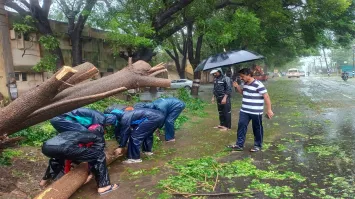Introduction:
In recent years, heavy rainfall events have become increasingly common in various parts of the world, including India. The Indian Meteorological Department (IMD) frequently issues heavy rainfall alerts during the monsoon season, especially between June and September. Such alerts are crucial for ensuring public safety, minimizing property damage, and reducing the loss of lives. A heavy rainfall alert typically warns citizens about excessive precipitation that may lead to flooding, landslides, and other natural calamities. Understanding the reasons behind these alerts and knowing how to respond to them can greatly reduce the risks associated with extreme weather conditions.
What is a Heavy Rainfall Alert?
A heavy rainfall alert is an official warning issued by weather authorities when a specific region is expected to receive an unusually high amount of rain within a short period. These alerts are categorized based on the severity of the rainfall and its potential impact. Generally, alerts are divided into three colors:
Yellow Alert: Be aware – indicates the possibility of heavy rainfall.
Orange Alert: Be prepared – suggests significant rainfall that might disrupt normal life.
Red Alert: Take action – warns of extremely heavy rainfall that can cause severe damage and pose a threat to life and property.
Such alerts are issued using data from weather satellites, radar systems, and ground-based observations. They are disseminated through television, radio, social media, and official government apps to reach the maximum number of people.
For more information: https://www.indiatvnews.com/news/india/cyclonic-storm-montha-live-updates-landfall-andhra-pradesh-coastal-region-chennai-weather-today-imd-red-alert-full-forecast-details-1014507
Causes of Heavy Rainfall:
Heavy rainfall occurs due to various meteorological factors. The most common causes include:
Monsoon Winds: During the southwest monsoon, moist air from the Arabian Sea and the Bay of Bengal moves inland, resulting in continuous rainfall over large parts of India.
Low Pressure Systems: Depressions and cyclonic circulations often bring intense rainfall, particularly over coastal and central regions.
Western Disturbances: These are weather systems originating in the Mediterranean region that cause rain and snow over northern India, especially during winter.
Local Convection: In tropical areas, the intense heating of land surfaces during the day can lead to local thunderstorms and heavy showers.
Climate Change: Global warming has intensified weather patterns, causing increased instances of extreme rainfall events in shorter durations.
Understanding these causes helps meteorologists forecast rainfall more accurately and issue timely alerts to prevent disasters.
Regions Frequently Affected by Heavy Rainfall:
Heavy rainfall is not uniform across India. Some regions are more prone to receiving excessive rainfall due to their geography and climate conditions. The Western Ghats, Northeast India, Konkan Coast, Kerala, and Himalayan foothills often experience continuous rainfall during the monsoon. Urban areas like Mumbai, Chennai, Kolkata, and Bengaluru also face severe waterlogging and flash floods due to inadequate drainage systems. In the Himalayan states such as Himachal Pradesh and Uttarakhand, heavy rain often triggers landslides and flash floods that damage roads and homes.
Impact of Heavy Rainfall:
The effects of heavy rainfall can be both positive and negative. While it replenishes groundwater, fills reservoirs, and supports agriculture, excessive rain can have devastating consequences if not managed properly.
Flooding: Continuous rainfall can overflow rivers and lakes, inundating low-lying areas and displacing thousands of people.
Landslides: In hilly regions, heavy rainfall loosens soil and rocks, leading to landslides that block roads and destroy villages.
Damage to Infrastructure: Roads, bridges, and buildings can be severely damaged, causing huge financial losses.
Disruption of Transportation: Rail, road, and air transport are often delayed or cancelled due to waterlogging and poor visibility.
Agricultural Losses: Excessive rain can destroy standing crops, especially rice, maize, and vegetables, leading to food shortages and economic losses for farmers.
Health Risks: Stagnant water after heavy rains becomes a breeding ground for mosquitoes, leading to diseases such as dengue, malaria, and chikungunya.
These impacts underline the importance of proactive planning and effective response mechanisms during heavy rainfall events.
For other information: https://indianexpress.com/article/cities/lucknow/cyclone-montha-effect-in-up-heavy-rainfall-alert-for-mirzapur-varanasi-divisions-10331620/
Government Preparedness and Response:
The Indian government, through agencies like the National Disaster Management Authority (NDMA) and the India Meteorological Department (IMD), plays a key role in disaster preparedness and response. IMD’s real-time rainfall forecasts are shared with state governments and local authorities to facilitate early evacuation and disaster mitigation measures. The Disaster Management Teams, NDRF (National Disaster Response Force), and local civic bodies are deployed to rescue stranded individuals and provide relief supplies in flood-hit areas.
Additionally, states have developed flood forecasting systems, installed automatic weather stations, and improved drainage networks in vulnerable urban areas. Public awareness campaigns through TV, radio, and social media also help people understand the meaning of alerts and take necessary precautions.
Safety Measures During Heavy Rainfall Alerts
When a heavy rainfall alert is issued, individuals and communities should take several precautionary steps to stay safe:
Avoid travelling to flood-prone or low-lying areas.
Keep emergency supplies such as food, water, flashlights, and first aid kits ready.
Stay updated through official weather bulletins and avoid believing unverified social media rumors.
Move to higher ground if heavy flooding is expected.
Avoid touching electrical equipment and wires during floods.
Help elderly persons, children, and pets to reach safe locations.
In urban areas, avoid driving through waterlogged roads as vehicles can easily get stranded.
These simple but effective measures can save lives and reduce property damage.
Role of Technology and Forecasting:
Modern technology has revolutionized weather forecasting. The IMD uses advanced radar networks, satellites like INSAT-3D, and numerical weather prediction models to provide accurate rainfall predictions. Mobile applications such as Mausam App, Rain Alarm, and MyGov Weather Alert deliver real-time weather updates to citizens. Drones and remote sensing tools are also used for damage assessment and post-disaster planning.

Conclusion:
Heavy rainfall alerts are essential for ensuring public safety in regions prone to extreme weather. While rainfall is vital for agriculture and water supply, excessive downpours can lead to severe natural disasters. By paying attention to official warnings, adopting precautionary measures, and improving infrastructure resilience, societies can significantly reduce the risks associated with heavy rainfall. Governments, meteorologists, and citizens must work hand in hand to build a safer and more climate-resilient future.


